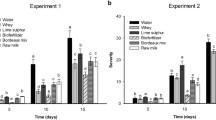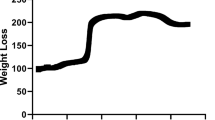Abstract
The efficacy of eight protein hydrolysates (PHs) of different origins, i.e., soybean (SoyA and SoyB), lupin (LupF and LupP), pea (Pea), yeast (Yeast), casein (Cas), and malt (Cer), in controlling gray mould of grapes, caused by Botrytis cinerea, was evaluated. In in vitro trials, the different PHs did not affect pathogen growth. Whereas, in in vivo trials, wound applications of SoyA, SoyB, LupP, and Cas showed significant effect in reducing rots on table grapes. SoyA and Cas were further tested at different concentrations against B. cinerea. A dose effect was observed, with the best activity recorded at 0.8 g/l, reducing gray mould of 67 and 54 % by SoyA and Cas, respectively. To simulate a commercial application, the experiment was repeated under natural infections, applying PHs at different doses by spray on detached berries. All doses induced a significant reduction of rots, and in general, there were no significant differences among the doses ≤6.4 g/l. Finally, the two hydrolysates were tested on wine grapes cv. Corvina. When applied in the field during growth phase until véraison, SoyA and Cas significantly reduced gray mould incidence by 65 and 92 %, as compared to water control, respectively. Whereas, a combination of pre- and postharvest application of SoyA and Cas reduced storage rots by 56 and 40 %, respectively. Overall SoyA proved to be the best treatment. Although the obtained results need further confirmation, they support the role of Cas and particularly SoyA as safe and effective alternative to traditional fungicides against gray mould of grapes, to be applied in the field and/or during postharvest phase.




Similar content being viewed by others
References
Aziz, A., Heyraud, A., & Lambert, B. (2004). Oligogalacturonide signal transduction, induction of defence-related responses and protection of grapevine against Botrytis cinerea. Planta, 218, 767–774.
Boller, T. (1995). Chemoperception of microbial signals in plant cells. Annual Review of Plant Physiology and Plant Molecular Biology, 46, 189–214.
Boehme, M., Schevtschenko, J., & Pinker, I. (2008). Use of biostimulators to reduce abiotics stress in cucumber plants (Cucumis sativus L.). Acta Horticulturae, 774, 339–344.
Boselli, M., Bahouaoui, M. A., Lachhab, N., Sanzani, S. M., & Ippolito, A. (2015). Vite: idrolizzati proteici contro lo stress idrico. L’Informatore Agrario, 22, 39–43.
Calvo, P., Nelson, L., & Kloepper, J. W. (2014). Agricultural uses of plant biostimulants. Plant and Soil, 383, 3–41.
Choct, M., Dersjant-Li, Y., McLeish, J., & Peisker, M. (2010). Soy oligosaccharides and soluble non-starch polysaccharides: a review of digestion, nutritive and anti-nutritive effects in pigs and poultry. Asian-Australasian Journal of Animal Sciences, 23, 1386–1398.
Colla, G., Rouphael, Y., Canaguier, R., Svecova, E., & Cardarelli, M. (2014). Biostimulant action of a plant-derived protein hydrolysate produced through enzymatic hydrolysis. Frontiers in Plant Science, 5, 448.
Droby, S., Wilson, C. L., Wisniewski, M., & El Ghaouth, A. (2001). Biologically based technology for the control of postharvest diseases of fruits and vegetables. In C. L. Wilson & S. Droby (Eds.), Microbial food contamination (pp. 187–205). Boca Raton: CRC Press LLC.
Ertani, A.., Cavani, L., Pizzeghello, D., Brandellero, E., Altissimo, A., Ciavatta, C., & Nardi, S. (2009). Biostimulant activity of two protein hydrolyzates in the growth and nitrogen metabolism of maize seedlings. Journal of Plant Nutrition and Soil Science, 172, 237–244.
Ertani, A., Schiavon, M., Adele, M., & Serenella, N. (2013). Alfalfa plant-derived biostimulant stimulate short-term growth of salt stressed Zea mays L. plants. Plant and Soil, 364, 145.
Fedrizzi, B., Tosi, E., Simonato, B., Finato, F., Cipriani, M., Caramia, G., & Zapparoli, G. (2011). Changes in wine aroma composition according to botrytized berry percentage: a preliminary study on amarone wine. Food Technology and Biotechnology, 49, 529–535.
Feliziani, E., Santini, M., Landi, L., & Romanazzi, G. (2013). Pre and postharvest treatment with alternatives to synthetic fungicides to control postharvest decay of sweet cherry. Postharvest Biology and Technology, 78, 133–138.
Gatto, M. A., Ippolito, A., Linsalata, V., Cascarano, N. A., Nigro, F., Vanadia, S., & Venere, D. (2011). Activity of extracts from wild edible herbs against postharvest fungal diseases of fruit and vegetables. Postharvest Biology and Technology, 61, 72–82.
Gauthier, A., Trouvelot, S., Kelloniemi, J., Frettinger, P., Wendehenne, D., Daire, X., Joubert, J. M., Ferrarini, A., Delledonne, M., Flors, V., & Poinssot, B. (2014). The sulfated laminarin triggers a stress transcriptome before priming the SA- and ROS-dependent defenses during grapevine’s induced resistance against Plasmopara viticola. PLOS One, 9, 1–13.
Hoa, T. T., & Ducamp, M. N. (2008). Effects of different coatings on biochemical changes of “cat Hoa loc” mangoes in storage. Postharvest Biology and Technology, 48, 150–152.
Ippolito, A., & Sanzani, S. M. (2011). Control of postharvest decay by the integration of pre- and postharvest application of nonchemical compounds. Acta Horticulturae, 905, 135–143.
Ippolito, A., El Ghaouth, A., Wilson, C. L., & Wisniewski, M. (2000). Control of postharvest decay of apple fruit by Aureobasidium pullulans and induction of defence responses. Postharvest Biology and Technology, 19, 265–272.
Iriti, M., Rosoni, M., Borgo, M., & Faoro, F. (2004). Benzothiadiazole enhances resveratrol and anthocyanin biosynthesis in grapevine, meanwhile improving resistance to Botrytis cinerea. Journal of Agricultural and Food Chemistry, 52, 4406–4413.
Karelin, A. A., Blishchenko, E. Y., & Ivanov, V. T. (1998). A novel system of peptidergic regulation. FEBS Letters, 428, 7–12.
Korhonen, H., & Pihlanto, A. (2006). Bioactive peptides: production and functionality. International Dairy Journal, 16, 945–960.
Lachhab, N., Sanzani, S. M., Adrian, M., Chiltz, A., Balacey, S., Boselli, M., Ippolito, A., & Poinssot, B. (2014). Soybean and casein hydrolysates induce grapevine immune responses and resistance against Plasmopara viticola. Frontiers in Plant Science, 716, 1–10.
Lachhab, N., Sanzani, S. M., Fallanaj, F., Youssef, K., Nigro, F., Boselli, M., & Ippolito, A. (2015). Protein hydrolysates as resistance inducers for controlling green mold of citrus fruit. Acta Horticulturae, 1065, 1593–1598.
Lisiecka, J., Knaflewski, M., Spizewski, T., Fraszczak, B., Kaluzewicz, A., & Krzesinski, W. (2011). The effect of animal protein hydrolysate on quantity and quality of strawberry daughter plants cv. Elsanta. Acta Scientiarum Polonorum Hortorum Cultus, 10, 31–40.
Mari, M., Neri, F., & Bertolini, P. (2010). New approaches for postharvest disease control in Europe. In D. Prusky & M. L. Gullino (Eds.), Postharvest pathology (pp. 119–136). Berlin: Springer.
McKinney, H. H. (1923). Influence of soil temperature and moisture on infection of wheat seedlings by Helminthosporium sativum. Journal of Agricultural Research, 26, 195–217.
Nigro, F., Ippolito, A., Lattanzio, V., Di Venere, D., & Salerno, M. (2000). Effect of ultraviolet-C light on postharvest decay of strawberry. Journal of Plant Pathology, 82, 29–37.
Nigro, F., Schena, L., Ligorio, A., Pentimone, I., Ippolito, A., & Salerno, M. G. (2006). Control of table grape storage rots by pre-harvest applications of salts. Postharvest Biology and Technology, 42(2), 142–149.
Randhir, R., Lin, Y. T., & Shetty, K. (2004). Phenolics, their antioxidant and antimicrobial activity in dark germinated fenugreek sprouts in response to peptide and phytochemical elicitors. Asia Pacific Journal of Clinical Nutrition, 13, 295–307.
Ribéreau-Gayon, P., Dubourdieu, D., Donèche, B., & Lonvaud, A. (2006). Handbook of enology volume 1, the microbiology of wine and vinification. Chichester: Wiley & Sons Inc.
Romanazzi, G. (2010). Chitosan treatment for the control of postharvest decay of table grapes, strawberries and sweet cherries. In D. Sivakumar (Ed.), Fresh produce—special issues: New trends in postharvest management of fresh produce (pp. 111–115). Japan: Global Science Books.
Romanazzi, G., Feliziani, E., Santini, M., & Landi, L. (2013). Effectiveness of postharvest treatment with chitosan and other resistance inducers in the control of storage decay of strawberry. Postharvest Biology and Technology, 75, 24–27.
Rosslenbroich, H. J., & Stuebler, D. (2000). Botrytis cinerea history of chemical control and novel fungicides for its management. Crop Protection, 19, 557–561.
Sanzani, S. M., Schena, L., Girolamo, A., Ippolito, A., & Gonzales-Candelas, L. (2010). Characterization of genes associated with induced resistance against Penicillium expansum in apple fruit treated with quercetin. Postharvest Biology and Technology, 56, 1–11.
Sanzani, S. M., Schena, L., De Cicco, V., & Ippolito, A. (2012). Detection and quantification of Botrytis cinerea in symptomless table grape stamens and berries. Postharvest Biology and Technology, 68, 64–71.
Schiavon, M., Pizzeghello, D., Muscolo, A., Vaccaro, S., Francioso, O., & Nardi, S. (2010). High molecular size humic substances enhance phenylpropanoid metabolism in maize (Zea mays L.). Journal of Chemical Ecology, 36, 662–669.
Świątecka, D., Małgorzata, I., Aleksander, Ś., Henryk, K., & Elżbieta, K. (2010). The impact of glycated pea proteins on bacterial adhesion. Food Research International, 43, 1566–1576.
Vercesi, A., Locci, R., & Prosser, J. I. (1997). Growth kinetics of Botrytis cinerea on organic acids and sugarsin relation to colonization of grape berries. Mycological Research, 101, 139–142.
Youssef, K., & Roberto, S. R. (2014a). Applications of salt solutions before and after harvest affect the quality and incidence of postharvest gray mold of ‘Italia’ table grapes. Postharvest Biology and Technology, 87, 95–102.
Youssef, K., & Roberto, S. R. (2014b). Salt strategies to control Botrytis mold of ‘Benitaka’ table grapes and to maintain fruit quality during storage. Postharvest Biology and Technology, 95, 95–102.
Youssef, K., Ligorio, A., Sanzani, S. M., Nigro, F., & Ippolito, A. (2012). Control of storage diseases of citrus by pre- and postharvest application of salts. Postharvest Biology and Technology, 72, 57–63.
Youssef, K., Sanzani, S. M., Ligorio, A., Ippolito, A., & Terry, L. A. (2014). Sodium carbonate and bicarbonate treatments induce resistance to postharvest green moldon citrus fruit. Postharvest Biology and Technology, 87, 61–69.
Zhang, X., & Schmidt, R. E. (1997). The impact of growth regulators on the a-tocopherol status in water-stressed Poa pratensis L. International Turfgrass Research Journal, 8, 1364–1373.
Acknowledgments
This work has been supported by the projects “Thirsty Grapes” funded by Regione Veneto (PSR2007-2013, mis. 124, n.2307790), and “ECO_P4” funded by Regione Puglia (PON02_00186_2866121). We acknowledge “A. Costantino & C. S.p.A.” (Favria, Turin, Italy) for providing the hydrolysates.
Author information
Authors and Affiliations
Corresponding author
Rights and permissions
About this article
Cite this article
Lachhab, N., Sanzani, S.M., Bahouaoui, M.A. et al. Effect of some protein hydrolysates against gray mould of table and wine grapes. Eur J Plant Pathol 144, 821–830 (2016). https://doi.org/10.1007/s10658-015-0749-x
Accepted:
Published:
Issue Date:
DOI: https://doi.org/10.1007/s10658-015-0749-x




